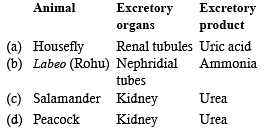31 Years NEET Previous Year Questions: Excretory Products & Their Elimination - 1 - NEET MCQ
25 Questions MCQ Test Biology 31 Years NEET Chapterwise Solved Papers - 31 Years NEET Previous Year Questions: Excretory Products & Their Elimination - 1
Presence of which of the following conditions in urine are indicative of Diabetes Mellitus? [2020]
Which of the following factors is responsible for the formation of concentrated urine? [2019]
| 1 Crore+ students have signed up on EduRev. Have you? Download the App |
The net pressure gradient that causes the fluid to filter out of the glomeruli into the capsule is:[2005]
In Ornithine cycle, which of the following wastes are removed from the blood? [2005]
Earthworms are [2006]
Bowman’s glands are located in the anterior pituitary [2007]
Lysozyme that is present in perspiration, saliva and tears, destroys [2007]
Consider the following four statements (a-d) about certain desert animals such as kangaroo, rat.
[2008]
(a) They have dark colour and high rate of reproduction and excrete solid urine
(b) They do not drink water, breathe at a slow rate to conserve water and have their body covered with thick hairs
(c) They feed on dry seeds and do not require drinking water
(d) They excrete very concentrated urine and do not use water to regulate body temperature
Which two of the above statements for such animals are true? [2008]
What will happen if the stretch receptors of the urinary bladder wall are totally removed ?
Uric acid is the chief nitrogenous component of the excretory products of [2009]
Which one of the following statements in regard to the excretion by the human kidneys is correct? [2010]
The principal nitrogenous excretory compound in humans is synthesised [2010]
Consider the following four statements (i-iv) regarding kidney transplant and select the two correct ones out of these. [2010]
(i) Even if a kidney transplant is proper the recipient may need to take immune suppresants for a long time
(ii) The cell mediated immune response is responsible for the graft rejection
iii) The B lymphocytes are responsible for rejection of the graft
(iv) The acceptance or rejection of a kidney transplant depends on specific interferons
The two correct statements are:
Which one of the following is not a part of a renal pelvis? [2011]
A large proportion of oxygen is left unused in the human blood even after its uptake by the body tissues. This O2 [2011]
Which one of the following correctly explains the function of a specific part of a human nephron ? [2011]
Which one of the following statements is correct with respect to kidney function regulation ? [2011]
Uricotelic mode of passing out nitrogenous wastes is found in [2011]
Ureters act as urogenital ducts in [2011M]
The maximum amount of electrolytes and water (70 - 80 percent) from the glomerular filtrate is reabsorbed in which part of the nephron ? [2012]
Which one of the following options gives the correct categorization of six animals according to the type of nitrogenous wastes (A, B, C), they give out? [2012M]

A fall in glomer ular filtration rate (GFR) activates [2012M]
Which one of the following characteristics is common to both in humans and adult frogs? [2012M]
Figure shown human urinar y system with structures labelled A to D. Select option which correctly identifies them and gives their characteristics and /or functions. [NEET 2013]

Select the option which shows correct matching of animal with excretory organs and excretory product [NEET Kar. 2013]

|
33 docs|83 tests
|
|
33 docs|83 tests
|

















